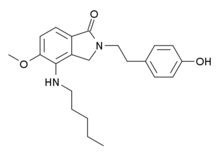JTE 7-31
From Wikipedia, the free encyclopedia
 |
|
| Names | |
|---|---|
| IUPAC name
2-[2-(4-hydroxyphenyl)ethyl]-5-methoxy-4-(pentylamino)-2,3-dihydro-1H-isoindol-1-one
|
|
| Identifiers | |
| 194358-72-0 |
|
| 3D model (Jmol) | Interactive image |
| ChemSpider | 13767708 |
| PubChem | 19363402 |
|
|
|
|
| Properties | |
| C22H28N2O3 | |
| Molar mass | 368.469 g/mol |
|
Except where otherwise noted, data are given for materials in their standard state (at 25 °C [77 °F], 100 kPa).
|
|
| Infobox references | |
JTE 7-31 is a selective cannabinoid receptor agonist invented by Japan Tobacco.[1][2] It is a reasonably highly selective CB2 agonist, but still retains appreciable affinity at CB1, with a Ki of 0.088nM at CB2 vs 11nM at CB1.
Legality[edit]
JTE 7-31 is illegal in Alabama.[3]
See also[edit]
- A-834,735
- JTE-907
- MDA-19
- N-(S)-Fenchyl-1-(2-morpholinoethyl)-7-methoxyindole-3-carboxamide
- S-444,823
- XLR-12
References[edit]
- ^ WO patent 1997/029079, Inaba T, Kaya T, Iwamura H, "Novel compounds and pharmaceutical use thereof", granted 1997-14-08
- ^ US patent 6017919, Inaba T, Kaya T, Iwamura H, "Compounds and pharmaceutical use thereof", granted 2000-01-25
- ^ Alabama Senate Bill SB 333: Controlled Substances
| This cannabinoid related article is a stub. You can help Wikipedia by expanding it. |